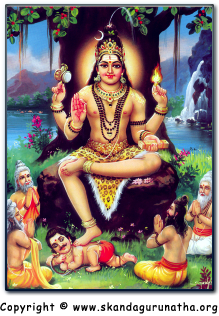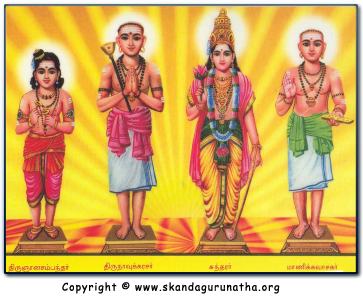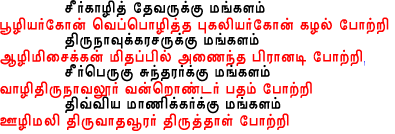By Dr. T. Arunachalam
|
Transliteration:
pUliyarkOn vepolitha pukaliyarkOn kalal pOtri
aalimisaik-kan mithappil aNaintha piraan-adi pOtri vaali-thiru-naavalUr vanRondar patham pOtri Ulimali thiruvaatha-vUrar thiru-thaaL pOtri Meaning:
My humble prostrations to the feet of great One from Pukali (Sambanthar).
My humble prostrations to the feet of the great One from Alimisai (Appar). My humble prostrations to the feet of the great One from Thiru-naavalUr (Sundarar). My humble prostrations to the feet of the great One from Thiru-vaatha-vUrar (Manikkavasagar). |
The acharya (spiritual teacher) has the highest place of honour in Saivism. The Sastras say that Siva Himself appears as the acharya at the proper moment and directs the bhakta (devotee) on the godward path.
 Dakshinamurthi (in the Siva temple) is the visual representation of the Supreme Guru. Under the kallaal (spreading fiscus tree) in Kailas, this murthi (idol) was seated in the pose of perfect peace and bliss. His form was that of a youth of sixteen years. Four-aged rishis (sages): Sanaka, Sanandana, Sanatana, and Sanatkumara came to Siva for spiritual instruction. He did not utter a word but his very pose gave them all the instruction they needed and they departed, enlightened and all their doubts dispelled.
Dakshinamurthi (in the Siva temple) is the visual representation of the Supreme Guru. Under the kallaal (spreading fiscus tree) in Kailas, this murthi (idol) was seated in the pose of perfect peace and bliss. His form was that of a youth of sixteen years. Four-aged rishis (sages): Sanaka, Sanandana, Sanatana, and Sanatkumara came to Siva for spiritual instruction. He did not utter a word but his very pose gave them all the instruction they needed and they departed, enlightened and all their doubts dispelled.
The pose of the right hand of Dakshinamurti is known as the Chin-mudra — the mudra of supreme knowledge. The right hand rests on the right knee, palm up; the forefinger bends, to touch the base of the thumb, itself released from contact with the other three fingers which stand out each separately and also separated from the forefinger. The thumb is the symbol of the Supreme God, the forefinger the soul who seeks eternal rest at the feet of God. When the forefinger touches the base of the thumb, it automatically separates itself from the other three fingers which represent the three bonds: anava (ego), karma (actions), and maya (illusion). The pose of the right hand signify that the soul overcomes bonds and attains final union with God. Dakshinamurthi is installed in this pose in a niche in all the Siva temples.
Siva (as Dakshinamurthi) is the Parama-acharya (Supreme Guru) in Kailas. In the terrestrial plane, are the four famously revered saiva saints known as Saiva Samaya Acharyas (naalvar):
- Thiru-nyana-sambanthar
- Thiru-navukk-arasar (Appar)
- Sundarar
- Manikkavasagar

The Four Saiva Samaya Acharyas had lived between the 7th and 9th centuries in Tamil Nadu, and the first three: Sambanthar, Appar, and Sundarar, in particular, had toured the innumerable Saiva shrines and by their songs helped the people to have greater faith and solace in Saivism and God. Ungodly faiths, such as Jainism and Buddhism, were subdued by them.
The Four Saiva Samaya Acharyas preached: the gospel of love and surrender to God; and service to God and godly men. Learning and a high position in life are immaterial. True love, devotion, and service to God is the only way one can obtain His Grace. God is One and He is Siva. The human souls should get over their bonds which keep them in ignorance and in the worldly fetters, and obtain inseparable union with Siva through the Lord's own Grace. This in brief is the substance of the four saints' philosophy and teachings.
By Swami Sivananda
It is customary to observe the day on which the four Saiva Samaya Acharyas attained the Lord's feet, as a holy day. Given below are such days in respect of the four great Saivite teachers, with their respective holy days, according to the Tamil Calendar. Pray, fast and study their lives on these days.
| Saint | Holy Day |
| Thiru-Naavukk-Arasar (Appar) | Chitrai Sadayam |
| Thiru-Nyana-Sambandhar | Vaikhasi Moolam |
| Manikkavasagar | Ani Maakham |
| Sundarar-Moorthi Nayanar | Adi Swathi |
References:
![]() Arunachalam, T. Tamil Hinduism. Singapore: EVS, 1998.
Arunachalam, T. Tamil Hinduism. Singapore: EVS, 1998.
![]() Sivananda, Swami. Sixty-Three Nayanar Saints. World Wide Web edition. India: Divine Life Society, 1999.
Sivananda, Swami. Sixty-Three Nayanar Saints. World Wide Web edition. India: Divine Life Society, 1999.
